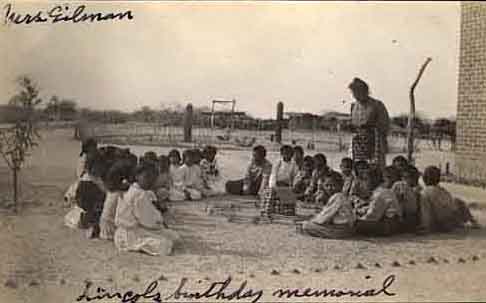
1. Mrs. Gillman and her students with model log cabin memorial for
Lincoln's birthday. |
Photographs of Indian Schools in Arizona
by
Eric Margolis
College of Education
and
Jeremy Rowe
Instructional Technology
Arizona State University
History of Education, Volume 33, Issue 2 March 2004 , pages 199 - 230
INTRODUCTION
This paper examines some recently discovered photographs of Arizona
Indian schools. The amateur snapshots were drawn from a personal album
of about one hundred and fifty photographs made or collected by a woman
who apparently taught at the Pima Indian school in Sacaton. Arizona schools
identified in the photo captions also include the Blackwater day school
Sacaton, Keams Canyon, and Rice Station boarding school. During the period
when these images were made each of these functioned as feeder schools,
funneling students to the off-reservation boarding school in Phoenix which
was the second largest in the country. We do not know the name of the woman
who made the album and the sketchy captions, hand written on the front
or back of the photographs, provide scant documentation. The images date
from ca. 1917 and provide tantalizing bits of information about the structure
of an Indian school, its environment in the desert South of Phoenix, and
the daily lives of the students and teachers. The images may have been
made by an acquaintance of one of the teachers at the school who captioned
the images and compiled the album. The album and brief captions provide
fascinating clues and a foundation for inferences and interpretations.
In her perceptive chapter on documentary entitled "Who is Speaking Thus?" Abigail Solomon-Godeau set forth a project for those who would use photographs in social and cultural research:
... individual documentary projects, themselves the product of distinct historical circumstances and milieus, "speak" of agendas both open and covert, personal and institutional, that inform their contents and, to a greater or lesser extent, mediate our reading of them. It is properly the work of historians and critics to attempt to excavate these coded and buried meanings, to bring to light these rhetorical and formal strategies that determined the work's production, meaning, reception, and use. (Solomon-Godeau 1991:182)
We will undertake Solomon-Godeau's suggestions in examining the
Arizona photograph album. As context, we will first provide a brief history
of Indian schools, in the next section we will examine the uses of photography
to represent Indians and Indian schools. The goal will be to describe the
social and cultural setting in which the photographs were made. We will
then turn to an examination of the actual snapshots in an attempt to decode
and unearth the meanings of the images.

1. Mrs. Gillman and her students with model log cabin memorial for
Lincoln's birthday. |
INDIAN BOARDING SCHOOLS
...imagine a people living in the heart of a civilized world but accepting
nothing of the supposedly higher standards of living of the "true bearers
of the torch." (Sloan 1930:460)
In several countries where Anglo European colonists occupied lands with
large indigenous tribal populations, the local people were subjected to
forced regimes of acculturation and assimilation. In the United States,
Canada, Australia and New Zealand, young children were taken far from their
parents and community, had their hair cut, were required to wear Euro-American
dress and forbidden to speak their mother tongue. In the U.S., alongside
quasi-military discipline and cultural "re-education," boarding schools
provided vocational training, art and music education, and sports. Frequently
young students were also farmed out to Anglo(1)
families for additional cultural re-education. In some places Native children
were adopted by white families. In each country the long term goal of "education"
was to eliminate the indigenous culture and in some fashion submerge those
populations in the dominant one.
In the United States Captain Richard Pratt established the Carlisle
Indian School in 1879. Pratt, like many other Anglo Americans, characterized
tribal societies as "Communistic," "indolent," "dirty," and "ignorant"
contrasting this with western civilization, characterized as "virile,"
"peaceable," "industrious," and "individualistic." Captain Pratt articulated
a systematic program of cultural extinction, arguing that: "The Indian
must die as an Indian and live as a man." He believed in subjecting Native
American youth to quasi-military discipline -- uniforms and drill exercises
alongside instruction in English and industrial training. Sports and regimented
band practice were likewise part of the disciplinary regime. Pratt developed
a system called "outing" to facilitate this enforced acculturation. In
Pratt's outing system students were first taught English and then were
farmed out to local families in Pennsylvania to attend public schools,
and participate in the community (Malmsheimer 1985:55). The Masthead of
the Carlisle school paper proclaimed another of Pratt's emblems: "To Civilize
The Indian; Get Him Into Civilization. To Keep Him Civilized; Let Him Stay."
He was opposed to returning children to the "Communistic government of
the tribes"(Trennert 1988:7).
Pratt's experiment at Carlisle became laid the basis for a network of
comparatively well-funded federal institutions with a coherent curriculum
intended to acculturate Native Americans to the dominant culture. Indian
schools were supported by powerful politicians such as General Thomas Morgan,
who became the Indian Commissioner a decade after the founding of Carlisle
and helped establish the network of off-reservation boarding schools. Morgan
justified the expense with the argument that is was "Cheaper to Educate
Indians than to Kill Them". (Trennert 1988:22). In the 1880's The Anglo
population of Phoenix, Arizona, began agitating Morgan to construct an
Indian school for the Pima and Maricopas who lived along the Gila River
in the southern part of the state. While these were peaceable farming communities,
who had actually aided the Whites in their battles with more resistant
tribes like the Apache, their culture was seen as amoral, indolent, and
worthless. Whites demanded that they be "Americanized" (Trennert 1988:12).
As Trennert's (1988) historical research made abundantly clear, Indian
schools also offered Phoenicians substantial economic benefits: purchases
of land and construction of buildings helped developers, federally funded
school payrolls flowed directly into the community, and federal contracts
supported local businesses that provided the school with services and supplies.
Perhaps most importantly, the school promised to train Indian students
and develop an "outing" system for them to work as cheap agricultural and
domestic labor. Eventually the school even became a tourist attraction.
For these reasons the school was actively supported by local boosters seeking
to promote the development of Phoenix.
Pennsylvania had essentially no indigenous population when Carlisle
was established, the Native American children brought there from the West
were a curiosity to the locals and posed no threat to the dominant social
order. In contrast, Arizona had the largest Indian population in the country.
The first superintendent of the Phoenix Indian school, Wellington Rich,
took a different tack from Pratt's: As Trennert explained:
(Rich) avoided the rhetoric so popular among eastern reformers about integrating Indians into white society. Knowing that immediate assimilation was not favorably regarded in frontier communities, he took a different approach. "I have no sympathy with the scheme of diffusing the educated Indian youth among the whites," he stated. "They should as a rule, in my opinion, return to their people and assist in the civilization of the latter." From the beginning then, the Phoenix Indian School deviated from eastern expectations. It would not be another Carlisle, and the term "Americanization," as used locally, had a different meaning. It was acceptable for the school to place great emphasis on vocational training, and students might even be encouraged to get work experience in town, but no one believed that large numbers of Indians were destined to live permanently in Phoenix as equals.(Trennert 1988:31)In the 1890's day schools, mission schools, and boarding schools for Native Americans were operating in a number of places in Arizona including the Navajo, Hopi, Apache, San Carlos, and Papago reservations. Desiring to make his new school appear successful, Superintendent Rich recognized that he needed to recruit not just what Whites denigrated as "Blanket Indians" fresh off the reservation, but students who were fluent English speakers and had already been subjected to the regime of schooling. In the early 1890's he even made an attempt to have an entire advanced class at the Pima school at Sacaton moved to the Phoenix school. Thus schools like Sacaton came to function as feeder schools for the Phoenix boarding school, while the Phoenix school defined its position as the "top of the educational pyramid" (Trennert 1988:36, 38). Superintendent Rich argued that Indians had to be taught to desire commodities and to accumulate property:
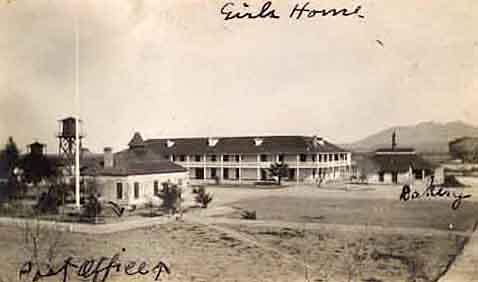
2. Overview of girls home, parade ground, post office and bakery at Sacaton, Arizona.
From the collection of Jeremy Rowe, Mesa, Arizona. © 2002
"In order to civilize, to make good citizens of Indian youth," (Rich) wrote in 1893, "it is absolutely necessary that they be inspired with a strong desire for better homes, better food, better clothing, etc., than they enjoy in their natural state, and that they be qualified to obtain these things by their own exertions." These goals could only be attained through specialized industrial training: "Hence each one should be taught an industry or trained for a calling which he can utilize by means of which he can earn a good living and accumulate property after leaving school." The end product would be an assimilated Indian, one whose traditional way of thinking and tribal life-style had been obliterated in favor of the individualism associated with American life. (Trennert 1988:34-35)
The hidden curriculum of capitalist consumption clearly took precedence
over the overt curriculum of industrial training. In fact, as the photographs
attest, what was being taught was not individualism at all; regimentation
and discipline was the main message. The curriculum emphasized uniforms,
marching, the rhythm of the time clock, rank and hierarchy, neatness and
cleanliness -- the hallmarks of industrial discipline. At the same time
Indian children were taught basic literacy and vocational training for
low-paid manual labor jobs: "...federal officials praised the superintendent
for 'having had experience enough in the Indian Service to know that an
Indian boy or girl will have to make their living by the "sweat of their
brow," and not by their brains' (Trennert 1988:47).
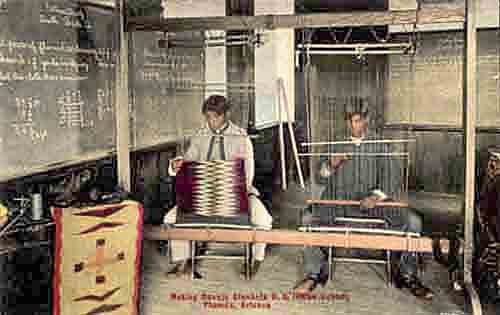
3. Making Navajo Blankets at the Phoenix Indian School , postcard
ca 1908. |
PHOTOGRAPHY
"Imperialism breeds an imperialist sensibility in all phases of cultural life. A safari of images." -- Martha Rosler (1981:78)
We will now briefly examine the peculiar role of photography in the history
of Indians and Indian education. Indian schools and students were frequently
photographed for the purposes of documentation, and as official records the
images were preserved in large numbers. Scholars have noted that at Carlisle
students were photographed when they arrived from the reservation in native
dress. They were photographed again after a period during which, as Malmsheimer
(1985:66n) noted, they had lived in cloudy Pennsylvania long enough to have
lost their sun tan and become visibly whiter, and they had been "scrubbed,"
had their hair cut, and were dressed in military uniform. While some of the
"before" photographs were posed informally, the "after"
shots confirmed to established conventions of middle-class portraiture, thus
reinforcing the predominantly white viewers' perception that a "civilizing
process" was being documented (Malmsheimer 1985:59). Pratt termed such
paired portraits "propaganda" and consciously employed them to demonstrate
the change from "Indian" to "man," from barbarism to civilization.
Malmsheimer (1985:56) explained that Pratt intended "Transformation of
the body (to stand) for transformation of the soul." These two images "Chiricahua
Apaches as they arrived at Carlisle from Fort Marion, Florida" and "Chiricahua
Apaches four months after arriving at Carlisle" are illustrative of this
propaganda effort.
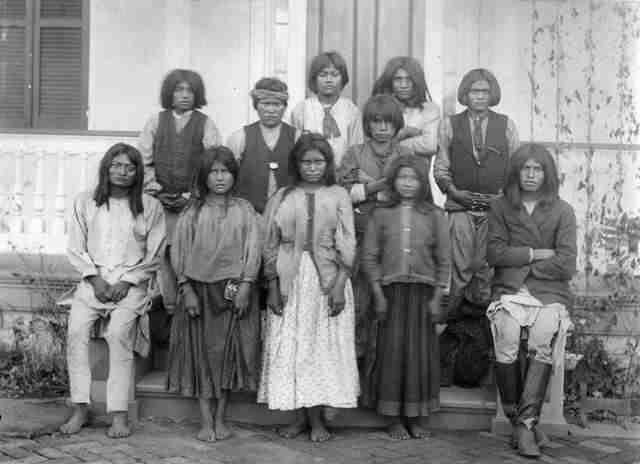
"Chiricahua Apaches as they arrived at Carlisle from Fort Marion, Florida"
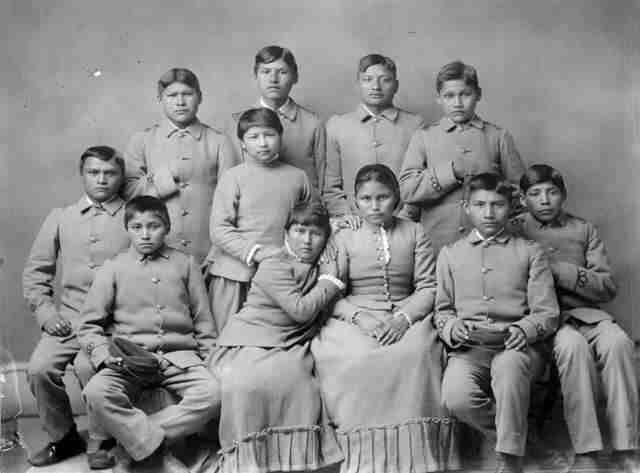
"Chiricahua Apaches four months after arriving at Carlisle"
Indian school photography played a unique role in manufacturing images
of acculturation and assimilation; photographs taken by Anglo photographers
were intended for Anglo viewers. Promotional photographs, and after about
1905 post cards, emphasized uniformed Native Americans in formation, engaged
in sports and occupational training, or studying in dormitories or individual
rooms with sparse Victorian dÈcor. Schools were represented as imposing
institutions and/or park like campuses (Margolis 1999:26-29). Images that
documented the Native American culture were rare and often focused on production
of the crafts that were marketed to the public in school operated gift
shops. As inexpensive hand held cameras fostered amateur photography, images
made at the schools by teachers and staff reflected similar themes and
provide compelling vernacular views of the pervasiveness of the acculturation
efforts. The depiction of the strength and regimentation of even unstructured
and recreational activities paints a chilling picture of the strictness
and structure used to insure the transformation.

4. Phoenix Indian Shool band, postcard ca 1910. |
Photographs of the Indian schools emphasized acculturation, civilization, obedience, work, and discipline. This photographic campaign dovetailed perfectly with the documentary project of Edward S. Curtis who, like many earlier "ethnographic documentation" projects, injected editorial control by adding or modifying the costumes and props that appear in the images. The first volume of Curtis's massive 20 volume work The North American Indian was published in 1907. Curtis called photography an "art-science" defining a role of the documentary photographer that went beyond notions that photographs were "documents" in the sense of "objective representations of what his subjects were" [Lyman, 1982 #66:18]. Curtis selected subjects that seemed to him to be noble primitives and carefully posed them to reinforce that perception. From time to time Curtis manufactured costumes or dressed his subjects in "Indian" clothes that he carried around in a trunk; he used scrims and tents, depth of field and framing to eliminate signs of modern life from his shots; he similarly retouched, cropped, and manipulated images in the dark room (Lyman 1982:62-78). The close analysis of Curtis's photographs performed by Christopher Lyman, demonstrates how he consciously created a vision of the "untutored savage" and a "vanishing race." Lyman described Curtis's photo entitled The Vanishing Race -- Navajo in this way:
A line of Indians diagonally traverses a murky foreground (the present) toward a threatening wall of darkness (the future) above which is an aura of light (Curtis' hope for improvement of Indians through assimilation into White culture). (Lyman 1982:80)
Like everyone, Curtis viewed the world through a cultural frames
of reference that operated as lenses and blinders -- allowing him to focus
on certain things while obscuring others. As Lyman noted: "Just as it was
difficult for Curtis to see Indians for what they were through the veil
of his culture at the time, so it is difficult for us to see him and his
work for what they were through the bias of our time" (Lyman 1982:19).
What has happened since 1900 cannot be forgotten, and from our vantage
in the 21st century there is no way to see except through the
bias of our time. The implications of this are profound, and raise a central
issue for this investigation. How is it that photographs of Indian students
and schools that were made to represent enlightenment and assimilation
-- in a word progress -- have come to our modern eyes to be images of oppression?
In
the discussion of the Arizona album that follows we will provide some answers.
There is a second question central to our interpretative effort that was posed by Alan Sekula, who asked: "How is historical and social memory preserved, transformed, restricted, and obliterated by photographs" (Sekula 1983:193)? Drawing attention to the problems of interpretation posed by historic photos. Sekula (Sekula 1983:195)warned that "Photography constructs an imaginary world and passes it off as reality." He termed a fallacy, assumptions that photographs "transmit truths"; "reflect reality"; or are "historical documents." "The very term document, entails a notion of legal or official truth, as well as a notion of proximity to and verification of an original event" (Sekula 1983:198). In contrast to the view of photos as documents, Sekula (Sekula 1983:194)drew attention to what he termed the "semantic availability" of images:
... not only are the pictures in archives often literally for sale, but their meanings are up for grabs....This semantic availability of pictures in archives exhibits the same abstract logic as that which characterizes goods on the marketplace.In an earlier article called "Class Pictures," Margolis (1999:8) echoed this perspective, noting:
In other words, regardless of the intent of the photographer, captions and documentary evidence preserved with the image, or attempts by the repository to control or restrict usage, photographs can and often are used in ways that may be quite antithetical to the original meanings (cf., Margolis 1994). Ripped free from context, photographs become free floating signifiers that appear to be little snippets of reality and can be used to bolster or "prove" a variety of contradictory theses.(3)
Each time a photograph is examined there are three variables that
combine to provide meaning: the photographer's intent, the image itself,
and the perspective of the viewer. The photographer's intent can frequently
be learned or deduced from captions, documentary material, other photographs
in a series, etc. The image itself can be examined from a number of perspectives
including the disciplines of semiotics, history, cultural criticism, literature
and so on. The goal is to describe as deeply as possible the iconic, indexical
and symbolic elements of the image (Nadin 1995). The last variable in this
equation is the one to which Sekula's observation speaks most directly.
The goal of the first two investigations is to gather as much evidence
of meaning as possible concerning the image in question. The third variable,
the standpoint and project of the observer, contributes to the selection
and codification of meanings from among those meanings available. Whether,
for instance, the viewer focuses on artistic style, symbolic meaning, or
historic context -- and which of the available meanings is chosen or foregrounded
-- has to do with the stance and standpoint of the observer.
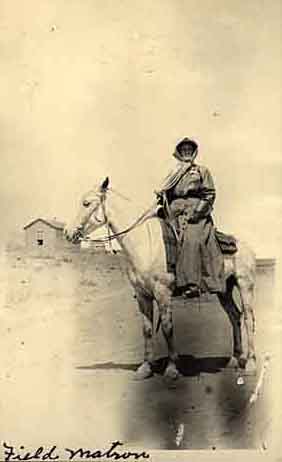
5. Field Matron, Sacaton Indian School. |
THE ARIZONA INDIAN SCHOOLS ALBUM
Who is the lady of Lofty mein
|
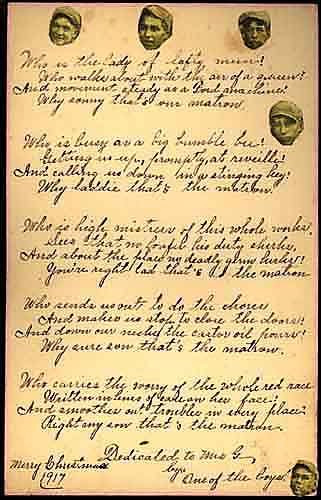
6. Christmas poem, 1917. |
The album included about 153 photographs which have been sequentially
numbered for reference. The first 76 shots were made at or near the Pima
Indian School in Sacaton, Arizona. The poem reproduced above ends the Sacaton
sequence. It is followed by a shot of a Saguaro cactus and two pages from
which once mounted photos were ripped. The rest of the images appear to
be a tour of Arizona with some emphasis on Indian schools: Grand Canyon,
Navajos, the Casa Grande ruins (with a caption explaining the Casa Grande
means Big House in Spanish), a touristy series on the Hopi reservation,
and a visit to Rice Station school. Unlike the Sacaton photographs, several
of these later images, primarily those of the Hopi ceremonials, were from
commercial sources and have been seen reproduced as post cards. Our analysis
will focus on the seventy-six shots made on or near the Pima School in
Sacaton. The site of the school was thirty miles south of Phoenix, two
miles west of present day Sacaton. There had been a number of schools serving
the Pima dating back to 1870, but the boarding school opened in 1881 (Carney
1974).
The photographs in the album are primarily 2.5 X 4.25 inches. They were
taken on 116 size roll film introduced in 1899 for the growing amateur
marketplace. Virtually all of the images are horizontal format. Based on
the size and format, the camera used was probably either a Kodak Brownie
or a relatively low cost folding camera such as the No. 1 Folding Kodak
(approximately $12). The slight wide angle lens visually over-emphasized
the distance between the photographer and subject increasing the sense
of separation. The small size of the viewfinder made exact composition
and awareness of subject expression difficult at best. Focusing was imprecise
as well, requiring the photographer to estimate distances and set the correct
focusing range. These cameras were extremely popular during this era and
film could be processed and printed by local photographers or other "Kodak"
processor. Prints were made by placing the negative on the photographically
sensitized paper which was exposed to light then processed, dried, and
trimmed if desired.
The simple rule of photographing with the sun over one's shoulder to
simplify exposure occasionally had unintended consequences. When photographing
with the sun low in the sky, either morning or afternoon, occasionally
a "self portrait" in the form of the photographer's shadow is visible in
the foreground. Several images in the album include such cues and were
taken by a man wearing a flat brimmed hat.
The photographs were consciously arranged both in an order, and aesthetically
on the pages of the album. The album is arranged vertically with two images
per page. A partial second set of un-mounted images was obtained along
with the album. Captions images in the album have been made in ink on the
face of the image. Additional captions and information had been penciled
on the reverse of the un-mounted images. In quoting captions we brought
both sources together.
In terms of the sequence of images and composition of the album, the
first eight photos in the album are of older boys in uniform. Nine through
25 focus on the exterior environment and most depict buildings identified
by captions and constitute a visual survey of the Pima school at Sacaton.
26-28 show the students lined up for dinner. According to the captions
there were 87 girls and 115 boys. Photo 29 is identified as "Laura. My
name sake." perhaps constituting a clue to the name of the author of the
album. Shots 30 through 37 are from a day trip to the Blackwater Day School
in Sacaton. Images 38-40 depict young female students in drill team formation,
while 48-52 are medium close-up posed portraits of older male students
who seem very acculturated to wearing uniforms or suits and ties.(4)
Photos 53 and 54, show the jail and police. The following eight shots,
62 through 70, are the only ones that address the Pima village adjacent
to the school. Included in this sequence is an image of "the lady who cares
for my clothes" discussed below. In an attempt to provide an even grander
general context the photographer climbed the water tower and made a couple
of long shots of Sacaton. Following the series of photographs a blank U.S.
Field Matron identification form was pasted in, suggesting that the author
was in fact a field matron. The last image was the poem to "our matron"
reproduced above.
It is probable that the photos in the album were made during the late
teens and perhaps in the single school year 1917-1918. Unfortunately, "1917"
on the above poem is the only date that appears in the album. That the
compiler of the album was a teacher or matron can be deduced from captions
to photos 9 and 10: "My six youngest, from 6 to 7 years old" and "Boys
dormitory. My room with the white paper in the window, wood box in the
corner." Interestingly, there are instructions on some of the prints. Shot
53, for instance, is captioned: "A Pima Home. Front view Mrs. Macks home.
The boy at the gate Herbert Jackson went with me. Send me one more of this."
And number twenty-seven "Going to dinner. Children marching in to dinner.
This is the only one you sent. I want one please. ..." These notes suggest
someone else, possibly the male whose shadow appears in several of the
photographs was the likely maker of the images and appears to have retained
possession of the negatives. The discourse also suggests that the author
of the album was being sent two copies of each shot, one included in the
album, the others retained as un-mounted images with additional notes and
captions. As noted, a few of these images were given to the subjects, but
the rest remained with the album in the effects of its compiler.
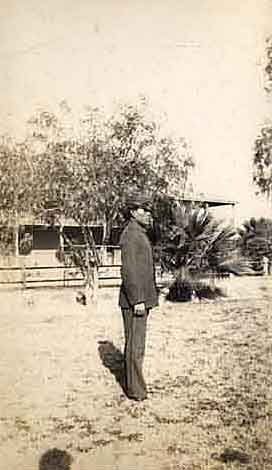
7. Erros Osif. He is the neatest and most gentleman(ly) one of the
boys - military suit. |
Even factoring in the wide-angle lenses of the time, there is a distance
between photographer and subject. Most of the images are long shots of
groups and the few portraits seem stiff. Photo 50 is typical of these portraits
of named older male students who seem highly acculturated and in positions
of authority. There are no similar portraits of female or younger students.
It is as if the only real contact the teacher/matron had was with "officers."
There are quite a few establishing shots -- portraits of the campus buildings
often including directions to adjacent buildings to orient the location
within the campus . Most of the captions are similar to number seventeen:
"Girl's home and Post Office. Laundry, Girl's Dormitory, P.O., and flagpole
view from the clubhouse. No. I Right Hand. Dormitory faces South, Supts
house East, School house North."
It is important to keep in mind that these were images made by an Anglo
American photographer and were produced for white eyes. The unknown photographer's
images, while not partaking directly in Pratt's project to use photography
to imagine social change, certainly provide a similar view of school settings
by emphasizing discipline and hierarchy. These relations were not, of course,
made by photography or the photographer, as Solomon-Godeau noted in a discussion
of gender:
...the structural determinations of the look, and the discursive strategies common to the representations themselves, indicate that the problems of oppression, subordination and objectification do not exclusively reside in the given contents of an image. Images, in other words, do not produce a world of female objects and male subjects; rather they may articulate, naturalize and confirm an oppression order whose roots lie elsewhere. (Solomon-Godeau 1991:221)
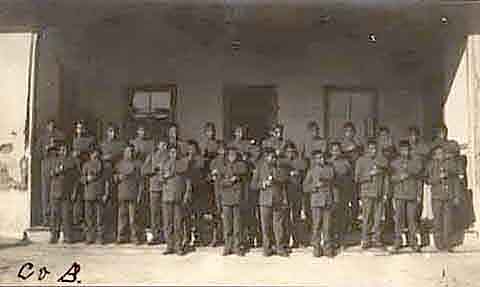
8. Co B Pima Indian School, Sacaton, AZ (hats in hand). |
The album begins by presenting older students of the school in a series of group portraits. The first eight images show disciplined young Indians in uniform arrayed formally in rank and file. Among other meanings, photos such as four and seven (below) confirmed to the Anglo viewer that indeed the Indian problem was being solved. At Sacaton, the young uniformed Indians were organized into three companies A B and C. Each group was posed twice -- once with hats on, one with hats in hand placed over heart in patriotic deference. These six shots were followed by two shots of smaller groups of older students in positions of authority identified as officers and buglers.
Erving Goffman (1961), in a foundational work of Symbolic Interactionism, Asylums, described the functioning of "total institutions" that separate and isolate members from the larger social world. The hallmarks of these organizations are what Goffman termed "mortifications of the self:" removal of personal possessions, loss of control over your schedule, uniforms, hair-cuts, and the inability to escape from organizational rules and procedures. In most of these settings the institutional goal is to recreate the individual to fit the demands of the organization. Indian boarding schools clearly fit Goffman's model which included prisons, monasteries and residential medical facilities. The project to develop total institutions to de-indianize young native Americans resided in the dominant Anglo-American social systems of which the photographic image system was both a trace and a functional element of the project itself. Far from emphasizing individualism, the curriculum obviously intended to replace one social identity, tribal, with another quasi-military identity. The essence of the new identity was obedience to authority. Trennert (1989:597) quoted Samuel Armstrong, the director of the Hampton Institute when it was an Indian School, to the effect that when they arrived the Indian children had:
"...absolutely no idea of obedience. They yield to a command when they feel it is just and reasonable, but simple obedience to authority seems an idea quite foreign to their minds, and is one of very slow growth."
Carol Carney (1974:8), a graduate student in the College of Education
at Arizona State University, interviewed Arnold Allison who had been a
student at Sacaton Boarding school from 1927-1932. Allison recalled the
daily regimen:
Trennert (1988:48) described similar regimes at the Phoenix Indian School where "...every aspect of student life was regulated." Trennert provided the ideological reasons given by the school superintendent for such regimentation:6:00 AM Students awakened by a bugle call; they had 15 minutes to wash, brush teeth, and make bed6:15 AM Practice marching and drilling
6:30 AM Breakfast
7:00 AM Do chores; sweep, clean dorms, wash dishes,
7:45 AM Dress in uniforms
8:00 AM Class starts with bugle call; young ones have class until 3:00, older children until 4:00
5:30 PM Supper
7:00-8:00 PM Night School for students who have fallen behind or have misbehaved.
"Too much praise can not be given to the merits of military organization, drill and routine in connection with the discipline of the school; every good end is obtained thereby. It teaches patriotism, obedience, courage, courtesy, promptness, and constancy; besides, in my opinion, it outranks any other plan or system in producing and developing every good moral, mental, and physical quality of the pupil." (1988:48)
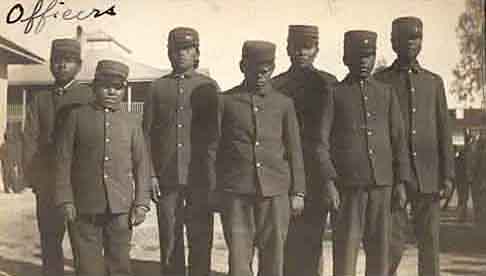
9. Officers A B and C Pima Indian School, Sacaton, AZ. |
The shot of unsmiling stern-looking Indian children selected to be officers
(photo 7) reveals other elements of the functioning of the boarding school
as a total institution. In the first place, rank and privilege were awarded
for good behavior; power over others was the reward for toeing-the-line
and demonstrating the attitudes and postures of acculturation. In the second
place, as in most total institutions, a reward system was employed to enforce
the rules, ensuring compliance among the "inmates" even when the teachers
or other agents of authority were not present. The third element of the
uses of "rank" takes a bit more explanation. We know from the work of Stanley
Milgram (1969; 1974) in his famous "obedience" experiments that distancing
the punisher from the one being punished makes obedience more likely. Establishing
a hierarchy of function in the machinery of discipline makes it possible
for every person in the chain of command to avoid responsibility for their
individual actions. Individuals thus become willing to engage in behavior
they might not have otherwise. This may simultaneously have had the effect
of distancing staff from the day-to-day need to punish small infractions.
In a caption to a photograph nearly identical to photo 4 above published
in Robert Trennert's article entitled Corporal punishment and the politics
of Indian reform, he made the point that older student "officers" were
"...placed in charge of younger pupils, and they enforced a disciplinary
system regarded by critics as harsh and demeaning" (Trennert 1989:609).
Although Trennert (1989) concluded that there was insufficient evidence
for some of the accusations, descriptions of excessive corporal punishment
at the Phoenix school seem to fit the chain of command model described
by Milgram: "...matrons regularly used male employees to whip unruly Indian
girls" (Trennert 1989:600). The school's "Indian disciplinarian" was accused
of "whipping, beating, and abusing Indian students" (p. 605). Another Indian
disciplinarian "...testified that in 1928 he participated in the mass flogging
of eighty little Indian boys because they had damaged a merry-go-round.
The floggings were carried out by larger Indian boys, under orders from
the disciplinarian, using a double thick harness strap" (p. 606). In each
case, those who set the rules and consequences of infraction were separated
from those who carried out the orders.
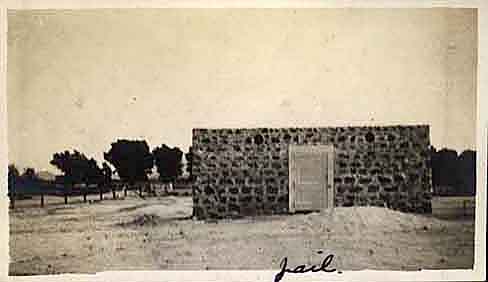
10. Jail at Sacaton Indian School. |
From Carlisle on down, Indian schools used confinement for discipline
problems and to lock-up runaways. Photo 53 depicts a small, isolated, adobe
building identified as the "jail" presumably at the Pima Indian School.
The use of jails was not abolished until 1929, the same year that corporal
punishment was forbidden (Trennert 1989:603). It is interesting, however
that this little jail was noteworthy enough to be included in the album.
Moreover, shots 53 and 54, jail and police, come after portraits of officers
suggesting an escalation of authority and implied control.
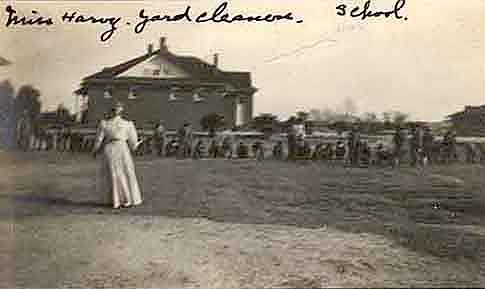
11. Miss Harvey with her yard cleaners at work. |
Solomon-Godeau argued that "...photography functions to ratify and affirm the complex ideological web that at any moment in historical time is perceived as tout court. ...photographs depicting the exotic native Other became fuel for the mission civilisatrice (Solomon-Godeau, 1991:171-172). Even though photo 22 is slightly out of focus, we reproduced it because it contains many elements of interest. Despite the fact that her back is to the camera, the dominant individual in the image is Miss Harvey; large, dressed in white, and in the foreground. Behind her are a group of 30 or more Indian students cleaning the school yard on their hands and knees. The image not only displays social status and rank, but the activity of yard cleaning by hand testifies to make-work discipline in service to neatness and cleanliness "for the mission civilisatrice." Trennert (1988:68) quoted the superintendent of the Phoenix school as saying:
"The child is taught how to do a thing, when to do it, and to do it whether he wants to or not." Indeed, teaching Indian students to work became the supreme goal of the institution, its motto being "Indolence is the cankerworm of progress, so our pupils are taught to kill the worm."
In 1928 a highly critical report on Indian schools, the Meriam report,
noted:
"Boarding schools are frankly supported in part by the labor of the students," who when they were as young as fifth graders, "work for half a day and go to school for half a day." The Meriam Report suggested, "The question may very properly be raised, as to whether much of the work of Indian children in boarding schools would not be prohibited in many states by child labor laws, notably the work in the machine laundries. (Szasz 1974:20)
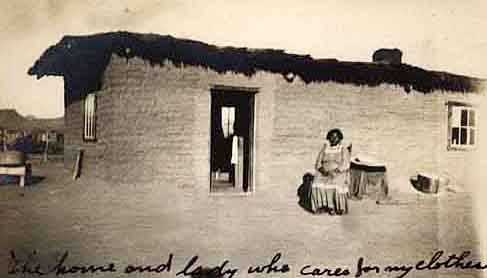
12. The home and lady who cares for my clothes. |
According to Trennert, although under the outing system Indian boys were seen as low wage competition to white labor and boys were hard to place in skilled positions, Indian girls became "fashionable" as servants to the local gentry. By the 1890's some boys were employed as seasonal field hands in cotton and citrus, and it was becoming difficult to provide enough Indian servant girls to meet demand as the outing system "evolved into a method of supplying cheap labor to white employers." By 1914,169 Indian girls from the Phoenix Indian school were working out as domestic servants (Trennert 1988:52, 54, 100-101). In their History of Arizona, Sloan and Adams (Sloan 1930) pointed out the tragic choice of Indian vocational education:
The training, which emphasizes industrial work, teaches the Indian child the American language and American ways of living. When he finishes school, the Papago returns to his native haunts and either ekes out his livelihood as best he can, or he leaves his people again to seek labor in some white community. Young Papago women are constantly hired as house maids, or, more often, as wash women.
We can infer that the "wash woman" in this photograph learned to
"care for clothes" in the Indian school both because there was no place
else to learn such a skill and because the schools intended to produce
trained and "Americanized" domestic workers to work for nearby Anglo families:
In 1900 "Commissioner Jones... stated that "Higher education in the sense ordinarily used has no place in the curriculum of Indian schools," the commissioner proclaimed. Using the training of Indian girls to make his point, he remarked that students should not expect to compete with white workers. Instead, they should learn the "dignity of work" and come to understand that the government owed them nothing "beyond a qualification for the actual duties of real life." (Trennert 1988:69)
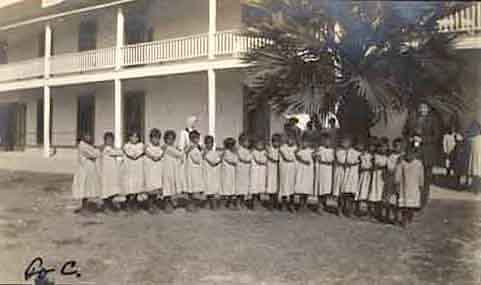
13. Girls of Co. C Drill. The little tots marching. |
It is instructive to remember that at the same time this campaign to
change Indians into Whites was being waged, many white children were going
to summer camp and being offered the opportunity to "play Indian." Philip
Deloria (1998) provided a fascinating analysis of the romantic attraction
whites had to the Indians they were trying to make extinct. At the same
time Indian children were being marched and drilled, Boy Scouts, Camp Fire
Girls, Woodcraft Indians, and dozens of summer camp programs attempted
to put Anglo children in touch with "the primitive" through camping out,
dressing up, and enacting made-up "Indian" rituals. At Sacaton, as in other
boarding schools, the children's labor was critical in the school's survival.
Trennert (1988:47) provided a glimpse of the conditions of institutional
life for these little girls in white dresses:
Womens' activities were supervised by the matron, and in addition to
classroom activities, they were put to work in such departments as housekeeping,
sewing, kitchen and dining room, or laundry. Like the boys, much of their
labor went into keeping the school solvent. They made, washed, and ironed
their own clothes; cleaned their rooms; swept, dusted, and scrubbed the
buildings; and prepared and served the food. Administrators claimed that
all such work had educational benefit. Superintendent Hall stated that
by cleaning rooms and dormitories, the girls strove "to excell each other
by performing their work and attaining that which makes the true woman
.... From slouchy, dissatisfied girls, the year produced neat, ladylike,
agreeable young ladies, who are proud of exhibiting their achievements,
and who I feel have made great strides toward civilization and the higher
aim in life."
CONCLUSION
Beginning in the mid 1920's a national outcry arose to reform the Indian schools (Szasz 1974:16ff). Corporal punishment and jails were prohibited in 1929 (Trennert 1989:603) and the American Indian boarding schools began to change in the 1930's during the Roosevelt administration. A controversial social worker, John Collier Jr. was appointed Commissioner of Indian Affairs in 1933 and began to push legislation constituting a "New Deal" for the American Indian. Collier wanted to the end land allotment process, which was breaking up the reservations, and restore economic and cultural control to the tribes. The Indian Reorganization Act of 1934 ended the Dawes General Allotment Act of 1887, which had sought to privatize Indian lands. The boarding schools began slowly to move away from military discipline and forced acculturation toward self-determination (Philip, 1977). Native arts and crafts were taught, and some ceremonials allowed. Unfortunately, unlike Pratt who understood and employed photography as a propaganda vehicle to exemplify "assimilation," Collier's administration did not make use of photographs.(5) Without much success, we sought Indian school images from the 1930's and 1940's depicting cultural integrity, Indian arts and crafts, traditional dance or ceremony. Most photography from the 1930's and 40's reproduces the previous generationís emphasis on order, cleanliness and assimilation. These four images from the Pierre SD Indian School were taken in 1937 and appear to be views from parents day or a craft fair that highlight Native American arts and crafts, archery, and a costume play.
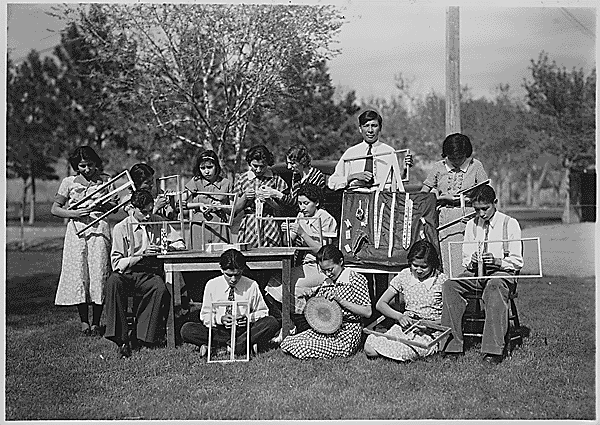
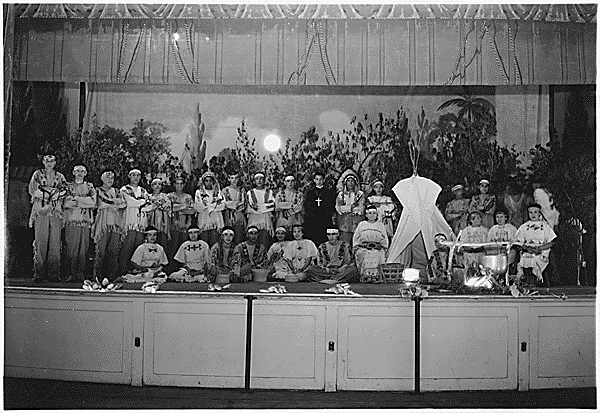
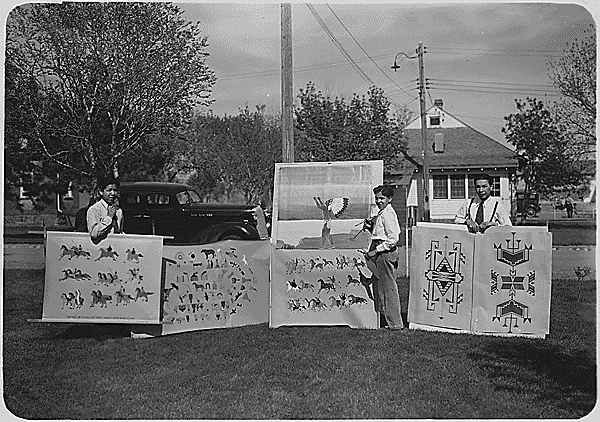
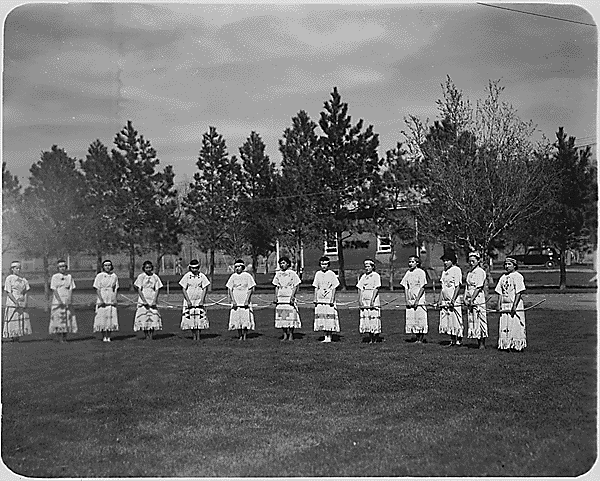
Pierre SD Indian School taken in 1937
This returns us to the issue of how Indian school photos, including those in
the album we examined, came to be seen as evidence of an oppressive system rather
than progress in the civilization of savages. Much has happened in the more
than eighty years since the photos were taken: most importantly, Indians didn't
vanish, in many cases the tribes increased in population and increasingly sought
to maintain their culture; the civil rights movement changed forever our view
of "the other;" and, under the impact of educational psychology, though
the transition took decades, the general view that children needed to be disciplined
through regimentation and harsh discipline is going the way of the buggy whip.(6)
In sum, the American culture and its frame of reference slowly evolved beyond
the philosophy of cultural genocide that was the genesis of the Indian Boarding
schools. The world view that supported Indian schools faded into historical
obscurity, as has much of the photographic record of this era. Although we attempted
a deeper understanding of these photos by providing context and discussion of
the cultural environment in which they were made, when we view the images of
these individuals and events we cannot help but see them through a filter of
today's cultural environment. Despite captions and all the tricks of the photographer's
trade, the images can be fixed in the dark room, but their meaning will continue
to develop.
1. We are using the term "Anglo" as it has commonly been used in the American Southwest. The population was historically characterized as Indian (Native American), Mexican (including Mexicano immigrants and Mexican Americans or Chicanos) and Anglo which included all sorts of English-speaking European Americans including recent immigrants and sometimes even Blacks.
2. There are two main sources on Indian school photography: Lonna M. Malmsheimer's 1985 article "Imitation White Man": Images of Transformation at the Carlisle Indian School; and the 1991 episode of the PBS series on the American Experience called: In the White Man's Image. See also the senior author's article on school photography: Class Pictures: Representations of Race, Gender and Ability in a Century of School Photography (Margolis 1999)
3. An anonymous reviewer of an earlier article on school photography, (Margolis 1999) correctly pointed out the reflexive confirmation of this quality of the image with the observation that: "One possible "antithetical" use, of course, is the sort that occurs in this article: critical social analysis of pictures not made with this purpose in mind."
4. According to Carol Carney, (1974:8) upper grade boys averaged 19 in age in 1921.
5. There is an element of irony here, because Collierís son, John Collier Junior, became a pioneer in the use of cameras in field research. His book Visual Anthropology (Collier and Collier 1986) is still in use. In it Collier advocated using cameras to record elements of culture and peopleís lives so that they might be studied and understood. One might see Collierís visual methodology as the antithesis of Curtisís view of photography as an "art-science." Visual Anthropology also offered an explicit alternative to the use of photography as a propaganda vehicle in the way that Prattís "before and after" shots were designed to do. Nonetheless, visual ethnographies of Native American life might have helped John Collier senior in political battles with advocates of enforced assimilation.
6. It is interesting to consider as Trennert (1989:596) noted: "Most Indian parents would have been horrified at the thought of striking their children." The view of Native American parents once considered ÏindolentÓ and "primitive" is very much in keeping with the modern views of child abuse. Laws even against spanking have been passed in several European countries.